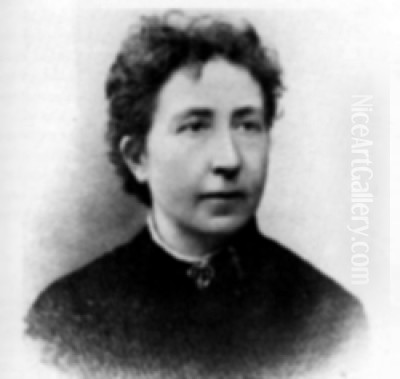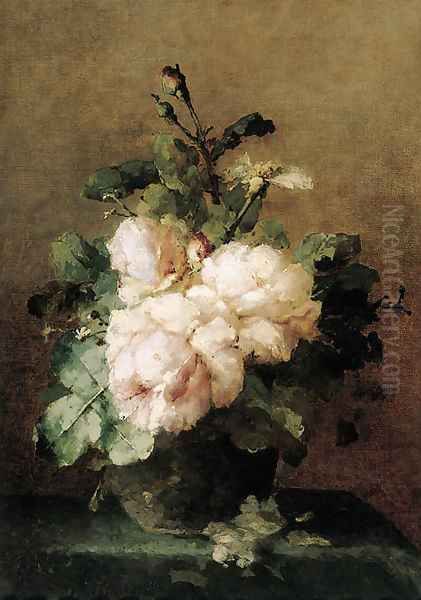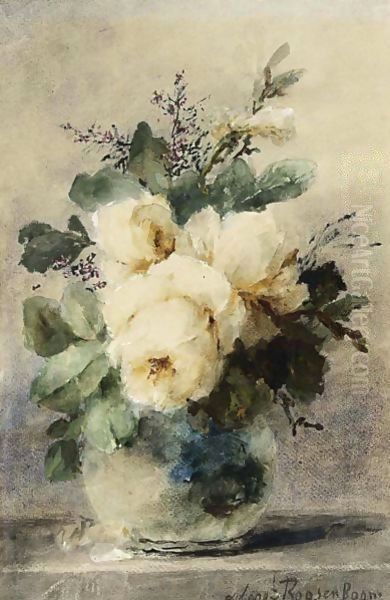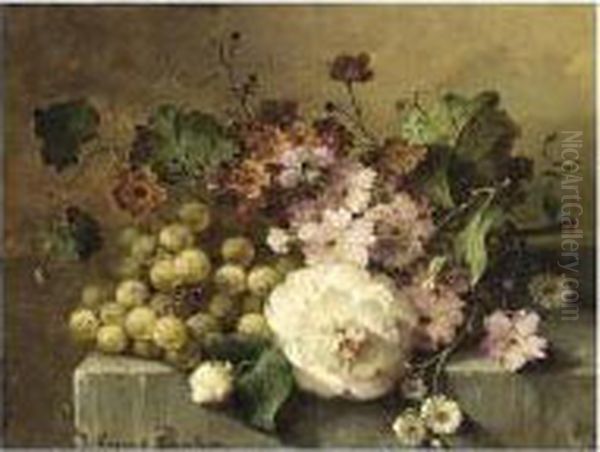
Margaretha Roosenboom stands as a distinguished figure in the rich tapestry of 19th-century Dutch art. A celebrated painter of flowers and fruit, she carved a niche for herself with her exquisite still lifes, particularly her vibrant and meticulously rendered depictions of roses. Born into an artistic lineage and flourishing in an era that saw a resurgence of interest in the Dutch Golden Age traditions, Roosenboom's work is characterized by its delicate sensitivity, harmonious color palettes, and a profound understanding of botanical forms. This exploration delves into her life, artistic education, signature style, notable works, and her interactions within the vibrant artistic milieu of her time, positioning her within the broader context of Dutch and European art history.
Early Life and Artistic Foundations
Margaretha Wilhelmina Johanna Roosenboom was born on October 24, 1843, in Voorburg, a town near The Hague in the Netherlands. Artistry was in her blood. Her father, Nicolaas Johannes Roosenboom (1805-1880), was a respected painter known for his landscapes, seascapes, and winter scenes, often working in the Romantic tradition. He had studied under the renowned landscape artist Andreas Schelfhout. Margaretha's mother, Maria Cornelia Margaretha Schelfhout (1811-1880), was the daughter of Andreas Schelfhout, further cementing the family's deep connection to the art world. This familial environment undoubtedly provided an early and immersive exposure to artistic practice and appreciation.
Initially, the Roosenboom family resided in Brussels, where Nicolaas was active as a painter. It was here, under her father's tutelage, that Margaretha received her first formal art lessons. This early instruction would have focused on the foundational skills of drawing and painting, likely encompassing various genres before she specialized. The artistic atmosphere of Brussels, a significant European cultural hub, would also have offered exposure to a diverse range of artistic styles and influences.
The Guiding Hand of Andreas Schelfhout

A pivotal moment in Margaretha Roosenboom's artistic development came in 1867 when she, along with her family, returned to The Hague. This move brought her into closer contact with her maternal grandfather, Andreas Schelfhout (1787-1870). Schelfhout was one of the most influential Dutch landscape painters of the Romantic period, celebrated for his meticulously detailed winter landscapes, panoramic views, and coastal scenes. His technical mastery, particularly in watercolor, was legendary.
Under Schelfhout's guidance, Margaretha honed her skills, especially in the medium of watercolor. His emphasis on precise observation, careful rendering of detail, and the subtle play of light and shadow would have profoundly impacted her approach. While Schelfhout was primarily a landscape artist, the principles of close observation of nature and technical finesse were transferable and highly valuable for a painter specializing in still lifes. The delicacy and translucency achievable with watercolors likely informed her later oil painting techniques, contributing to the luminous quality of her floral depictions.
Emergence as a Flower Painter and Artistic Style
Margaretha Roosenboom quickly distinguished herself as a specialist in flower and fruit still lifes. This genre had a long and illustrious history in Dutch art, reaching its zenith during the 17th-century Golden Age with masters like Jan Davidsz. de Heem, Rachel Ruysch, and Jan van Huysum. By the 19th century, there was a renewed appreciation for this tradition, and Roosenboom emerged as one of its leading contemporary exponents.
Her style is characterized by a remarkable sensitivity to the natural beauty of her subjects. She possessed an exceptional ability to capture the delicate textures of petals, the subtle gradations of color, and the interplay of light on surfaces. Her compositions, while often seemingly informal, were carefully arranged to create a sense of balance and harmony. Unlike some of her 17th-century predecessors who often depicted opulent, almost overwhelming bouquets with symbolic undertones, Roosenboom's approach was generally more intimate and focused on the inherent beauty of the flowers themselves.
Roses were a particular favorite and a recurring motif in her oeuvre. She painted them with an evident affection, capturing their velvety petals, rich colors – from deep crimsons and vibrant pinks to delicate whites and yellows – and their characteristic forms, whether in full bloom, as budding flowers, or gently wilting. Her roses often possess a heroic, almost sculptural quality, commanding the viewer's attention. She frequently chose to depict a single type of flower in a composition, allowing for an intensive study of its specific characteristics.

Her palette was rich and varied, yet always harmonious. She masterfully blended colors to achieve naturalistic effects, and her brushwork, while precise, often had a relaxed, fluid quality that imbued her paintings with a sense of freshness and vitality. Critics of her time praised her for the "juicy" quality of her fruit and the lifelike vibrancy of her flowers, noting the fine color harmony and the appealing, almost tangible, nature of her subjects.
Notable Works and Artistic Achievements
Margaretha Roosenboom's oeuvre includes numerous exquisite still lifes that showcase her mastery. Among her representative works, paintings titled Still Life with Roses are numerous and consistently demonstrate her skill. These pieces typically feature lush arrangements of roses, often in a vase or casually strewn on a surface, rendered with her characteristic attention to detail and vibrant color. One such Still Life with Roses was noted for auction with an estimate of €6,000 to €10,000, indicating the continued appreciation for her work.
Another significant piece is A Still Life With Peonies In A Vase. Peonies, with their voluminous petals and rich colors, provided another excellent subject for her talents, and this work would have exemplified her ability to capture the opulence and delicate structure of these blooms.
Her talent did not go unnoticed. Even at the young age of 16, she was considered a child prodigy, exhibiting her work at the prestigious Pulchri Studio in The Hague. Founded in 1847, Pulchri Studio was (and remains) an influential artists' society, and exhibiting there was a mark of recognition. She officially became a member of Pulchri Studio in 1878, at the age of 35, further solidifying her position within the Dutch art establishment.
Roosenboom's reputation extended beyond the Netherlands. She actively sent her works to international exhibitions, gaining accolades and recognition on a broader stage. She received awards at several major World's Fairs:
The Vienna World's Fair in 1873.
The World's Columbian Exposition in Chicago in 1893, where her work was displayed in the Palace of Fine Arts.
The Cotton States and International Exposition in Atlanta in 1895.
These international awards underscore the high regard in which her art was held by her contemporaries globally.
The Hague School and Artistic Contemporaries
Margaretha Roosenboom worked during the period when The Hague School (Haagse School) was the dominant artistic movement in the Netherlands. Active roughly between 1860 and 1890, The Hague School artists were known for their realistic depictions of Dutch landscapes and everyday life, often characterized by muted colors and an emphasis on capturing mood and atmosphere. Key figures included Jozef Israëls, Anton Mauve, Jacob Maris, Willem Maris, Hendrik Willem Mesdag, and Willem Roelofs.

While Roosenboom's subject matter – still life – differed from the landscapes and genre scenes favored by many Hague School painters, she shared their commitment to realism and the careful observation of nature. Her grandfather, Andreas Schelfhout, though more aligned with Romanticism, was a precursor to The Hague School in his detailed naturalism and can be seen as a bridge figure. The artistic environment of The Hague, energized by Pulchri Studio and the presence of these prominent artists, would have been stimulating for Roosenboom.
She was also part of a notable group of female artists active in the Netherlands during this period. The 19th century saw increased opportunities for women in the arts, although they still faced challenges. Roosenboom, along with figures like Sientje Mesdag-van Houten (1834-1909), also a still life and landscape painter and wife of Hendrik Willem Mesdag, and Gerardina Jacoba van de Sande Bakhuyzen (1826-1895), another renowned flower painter, contributed significantly to the Dutch art scene.
A testament to her collaborative spirit and standing among her female peers is the work Haagse Weesmeisjes (The Hague Orphan Girls). This painting was a collaborative effort created in 1874 by Roosenboom, Gerardina van de Sande Bakhuyzen, Kate Bisschop-Swift (Catherine Seaton Forman Swift, 1834-1928, wife of painter Christoffel Bisschop), and Sientje Mesdag-van Houten. The work was presented to Queen Sophie of the Netherlands, wife of King William III, highlighting the artists' collective prominence and their engagement with royal patronage. Such collaborations were not uncommon and demonstrated a sense of community among artists.
Other notable Dutch female artists of the general period, though perhaps not direct collaborators, who contributed to the visibility of women in art include Thérèse Schwartze (1851-1918), a celebrated portraitist, and Suze Robertson (1855-1922), known for her expressive figural works. Internationally, the French painter Henri Fantin-Latour (1836-1904) was a contemporary highly acclaimed for his exquisite flower paintings, offering an interesting point of comparison in terms of subject matter and the prevailing realist tendencies in still life.
The Enduring Tradition of Dutch Flower Painting
Roosenboom's dedication to flower painting places her firmly within a venerable Dutch tradition. The 17th-century Dutch Golden Age saw an explosion in the popularity of still life painting, with flower pieces being particularly sought after. Artists like Ambrosius Bosschaert the Elder (1573-1621), Balthasar van der Ast (1593/94-1657), Jan Brueghel the Elder (1568-1625, though Flemish, highly influential), Rachel Ruysch (1664-1750), and Jan van Huysum (1682-1749) created breathtakingly detailed and often symbolically rich depictions of flowers. These paintings were prized for their technical brilliance, their celebration of natural beauty (and often exotic, expensive blooms), and sometimes for their vanitas connotations, reminding viewers of the transience of life and beauty.
By the 19th century, while the overt symbolism might have been less emphasized, the appreciation for botanical accuracy and aesthetic beauty remained. Roosenboom and her contemporaries inherited this legacy, adapting it to the sensibilities of their own time. Her work, like that of her predecessors, demonstrates a deep love for and understanding of the plant world. She continued the tradition of meticulous observation but often imbued her work with a slightly softer, more romantic or impressionistic touch compared to the sometimes hyper-realism of the Golden Age masters. Her focus was less on encyclopedic displays of various species and more on the singular beauty of chosen blooms, often presented in a more naturalistic, less overtly contrived manner.
Personal Life and Later Years
In 1892, at the age of 49, Margaretha Roosenboom married the painter Johannes Gijsbert Vogel (1828-1915). Vogel was also a landscape painter and had been a student of Andreas Schelfhout, creating another link within this artistic family circle. They had one son. Her marriage occurred relatively late in her life, after she had already established a significant career.
She continued to paint and exhibit throughout her life. Her dedication to her art remained steadfast. Margaretha Roosenboom passed away on May 26, 1896, in Voorburg, the town of her birth, at the relatively young age of 52. Despite her life not being exceptionally long, she left behind a substantial body of work that continues to be admired.
Legacy and Conclusion
Margaretha Roosenboom's legacy is that of a highly skilled and sensitive painter who made a significant contribution to Dutch still life painting in the 19th century. She successfully navigated the art world of her time, gaining recognition both nationally and internationally. Her works are prized for their technical excellence, their beautiful depiction of flowers and fruit, and their embodiment of a refined aesthetic sensibility.
Her paintings can be found in various museums and private collections, including the Museum Flehite in Amersfoort and the Rijksmuseum in Amsterdam. They serve as a testament to her talent and her role in continuing and revitalizing the esteemed Dutch tradition of flower painting. She stands alongside other notable female artists of her era who asserted their presence and talent in a field still largely dominated by men.
In an art historical context, Roosenboom's work bridges the detailed Romanticism inherited from her grandfather and the broader realist currents of The Hague School. She brought a personal vision to a traditional genre, infusing her flower paintings with a freshness, vibrancy, and an intimate appreciation for natural beauty that remains appealing to viewers today. Her dedication to her craft, particularly her masterful rendering of roses, ensures her a lasting place in the annals of Dutch art. Margaretha Roosenboom was more than just a painter of flowers; she was a poet of their ephemeral beauty, capturing their essence with a skill and passion that continues to resonate.